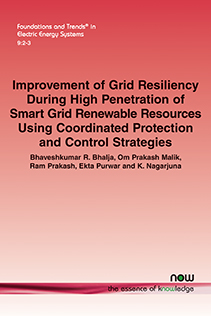Improvement of Grid Resiliency During High Penetration of Smart Grid Renewable Resources Using Coordinated Protection and Control Strategies
By Bhaveshkumar R. Bhalja, Department of Electrical Engineering, Indian Institute of Technology Roorkee, India, bhavesh.bhalja@ee.iitr.ac.in | Om Prakash Malik, Department of Electrical and Software Engineering, University of Calgary, Canada, maliko@ucalgary.ca | Ram Prakash, Department of Electrical Engineering, Indian Institute of Technology Roorkee, India, ram.pd@ee.iitr.ac.in | Ekta Purwar, Department of Electrical Engineering, Indian Institute of Technology Roorkee, India, purwar.ekta21@gmail.com | K. Nagarjuna, Department of Electrical Engineering, Indian Institute of Technology Roorkee, India, k_nagarjuna@ee.iitr.ac.in
Abstract
The growing integration of renewable energy sources (RESs), particularly inverter-based distributed generators (IBDGs), into modern power systems presents profound challenges to conventional grid protection and control schemes, thereby impacting overall grid resiliency. This monograph presents a comprehensive investigation into these challenges, aiming to develop and validate adaptive solutions for systems with high penetration of RESs. It commences with a detailed examination of the evolving concept of grid resiliency and analyses the complex fault response behaviours introduced by RESs, which often exhibit limited and controlled fault current contributions. This fundamental shift in fault characteristics highlights the inherent limitations of traditional protection schemes, especially distance relays, which were designed for grids dominated by synchronous generators and often fail to operate reliably in the presence of low-inertia, power-electronics-based RESs. The need for adaptive protection schemes and updated grid codes for modern distribution and transmission systems is thoroughly discussed.
The monograph also presents a detailed modelling of RESs, including solar photovoltaic, wind energy systems, and battery energy storage systems (BESS) with their necessary control schemes for effective grid integration. Major control techniques explored include grid-forming and grid-following inverter controls, droop control, virtual inertia emulation, and d-q current control. An in-depth analysis of proportional-integral and proportional-resonant controllers is provided to optimize inverter performance for enhanced grid stability. The performance degradation of conventional distance protection schemes in RES-dominated networks is analysed through simulation studies, revealing critical issues in fault detection, coordination, and isolation. To address these limitations, various adaptive distance protection techniques for RES-dominated grids are suggested. The comparative analysis of these adaptive and conventional distance protection techniques, simulated using RTDS and PSCAD/EMDC software, shows the efficacy of the adaptive methods.
Furthermore, the monograph explores the advanced methodologies for significantly improving overall grid resiliency, with a focus on the acceleration of second-zone protection of distance relays. Both theoretical analyses and simulation-based validations are presented to substantiate the effectiveness of these approaches in enhancing fault clearance times and system stability. It provides valuable insights and practical frameworks for developing coordinated protection and control strategies, which are indispensable for ensuring secure, reliable, and resilient grid operations amidst the escalating integration of RESs.
Improvement of Grid Resiliency During High Penetration of Smart Grid Renewable Resources Using Coordinated Protection and Control Strategies
Power systems are getting increasingly complex due to growing electricity demand, decentralized generation (DG), integration of renewable energy sources (RESs), deregulation, and modernization. As a result, grid resiliency is no longer optional; it is a necessity to keep the whole power system network operating reliably amid growing complexity and uncertainty. Grid resiliency is majorly impacted by aging infrastructure, integration of RESs, and environmental, operational, and cybersecurity factors. The changing grid infrastructure and digitalization make traditional power systems vulnerable to power quality issues and cyber attacks. The contribution of power generated by RESs is rapidly increasing in the power system due to environmental concerns, growing efficient technology, and sustainability.
Methods to improve grid resiliency are broadly classified into three categories, namely prevention, adaptation, and recovery. Prevention refers to pre-event hardening methods like grid modernization, infrastructure upgrades, and integrating distributed energy resources (DERs) and energy storage systems (ESS). Adaptive methods include real-time response like FRT enhancement, self-healing grid, and cybersecurity measures. The post-event restoration or recovery strategies utilize mobile distributed power sources, priority-based load restoration, demand response programs, and disaster management teams for faster response.
This monograph provides a comprehensive analysis of the challenges and solutions associated with integrating RESs into modern power systems. The work systematically explores the impact of RES integration on conventional protection schemes and introduces adaptive strategies to overcome associated challenges. Furthermore, the monograph highlights the importance of grid-forming inverters and d-q current control methods in ensuring stable power conversion and seamless grid synchronization. Simulation results and case studies validate the effectiveness of these strategies, showcasing their potential to enhance fault detection, isolation, and system recovery in RES-rich environments.
